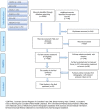Prevalence, contributory factors and severity of medication errors associated with direct-acting oral anticoagulants in adult patients: a systematic review and meta-analysis
- PMID: 34935068
- PMCID: PMC8926953
- DOI: 10.1007/s00228-021-03212-y
Prevalence, contributory factors and severity of medication errors associated with direct-acting oral anticoagulants in adult patients: a systematic review and meta-analysis
Abstract
Purpose: This study aimed to estimate the prevalence, contributory factors, and severity of medication errors associated with direct acting oral anticoagulants (DOACs).
Methods: A systematic review and meta-analysis were undertaken by searching 11 databases including Medline, Embase, and CINHAL between January 2008 and September 2020. The pooled prevalence of errors and predictive intervals were estimated using random-effects models using Stata software. Data related to error causation were synthesised according to Reason's accident causation model.
Results: From the 5205 titles screened, 32 studies were included which were mostly based in hospitals and included DOAC treatment for thromboembolism and atrial fibrillation. The proportion of study population who experienced either prescription, administration, or dispensing error ranged from 5.3 to 37.3%. The pooled percentage of patients experiencing prescribing error was 20% (95% CI 15-25%; I2 = 96%; 95% PrI 4-43%). Prescribing error constituted the majority of all error types with a pooled estimate of 78% (95%CI 73-82%; I2 = 0) of all errors. The common reported causes were active failures including wrong drug, and dose for the indication. Mistakes such as non-consideration of renal function, and error-provoking conditions such as lack of knowledge were common contributing factors. Adverse events such as potentially fatal intracranial haemorrhage or patient deaths were linked to the errors but causality assessments were often missing.
Conclusions: Despite their favourable safety profile, DOAC medication errors are common. There is a need to promote multidisciplinary working, guideline-adherence, training, and education of healthcare professionals, and the use of theory-based and technology-facilitated interventions to minimise errors and maximise the benefits of DOACs usage in all settings.
Protocol: A protocol developed as per PRISMA-P guideline is registered under PROSPERO ID = CRD42019122996.
Keywords: Direct acting oral anticoagulants (DOACs); Medication errors; Meta-analysis; Non-vitamin K antagonist oral anticoagulants; Systematic review.
© 2021. The Author(s).
Conflict of interest statement
The authors declare no competing interests.
Figures





References
-
- National institute for Health and Care Excellence (2014) Atrial fibrillation: management Available at: https://www.nice.org.uk/guidance/cg180. Accessed 10 July 2021 - PubMed
-
- Joint Formulary Committee (2020) British National Formulary 79. Available at: http://www.medicinescomplete.com. Accessed: 10 July 2021
-
- Steiner T, Böhm M, Dichgans M, Diener HC, Ell C, Endres M, Epple C, Grond M, Laufs U, Nickenig G, Riess H, l Recommendations for the emergency management of complications associated with the new direct oral anticoagulants (DOACs), apixaban, dabigatran and rivaroxaban. Clin Res Cardiol. 2013;102(6):399–412. doi: 10.1007/s00392-013-0560-7. - DOI - PubMed
Publication types
MeSH terms
Substances
LinkOut - more resources
Full Text Sources
Medical

